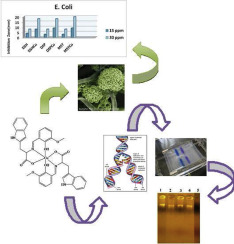Three tridentate Schiff bases amino acids were prepared by direct condensation of 3-methoxysalicylaldehyde (MS) or 4-diethylaminosalicylaldehyde (DS) with α-amino acid ligands [l-phenylalanine (P), l-histidine (H) and DL-tryptophan (T)]. The prepared Schiff bases amino acids were investigated by melting points, elemental analysis, 1HNMR and 13CNMR, IR, UV–Vis spectra, conductivity and magnetic measurements analyses. Subsequently, copper was introduced and Cu(II) complexes formed. These complexes were analyzed by thermal and elemental analyses and further investigated by FT-IR and UV/Vis spectroscopies. The experimental results indicating that all Cu(II) complexes contain hydrated water molecules (except DSPCu complex) and don't contain coordinated water molecules. The kinetic and thermal parameters were extracted from the thermal data using Coast and Redfern method. The molar conductance values of the Schiff base amino acid ligands and their Cu(II) complexes were relatively low, showing that these compounds have non-electrolytic nature. Magnetic susceptibility measurements showed the diamagnetic nature of the Schiff base amino acid ligands and paramagnetic nature of their complexes. Additionally, a spectrophotometric method was determined to extract their stability constants. It was found that the complexes possess 1:2 (M:L) stoichiometry. The results suggested that 3-methoxysalicylaldehyde and 4-diethylaminosalicylaldehyde amino acid Schiff bases behave as monobasic tridentate ONO ligands and coordinate Cu(II) ions in octahedral geometry according to the general formula [Cu(HL)2]·nH2O. To further understanding the structural and electronic properties of these complexes, Density Functional Theory (DFT) calculations were employed and provided a satisfactory description. The optimized structures of MST Schiff base ligand and its complex were calculated using DFT. The antimicrobial activity of the Schiff base ligands and their complexes were screened against some types of bacteria such as Bacillus subtilis (+ve), Escherichia coli (−ve) and Micrococcus luteus (+ve) and some types of fungi such as Asperagillus niger, Candida glabrata and Saccharomyces cerevisiae. The results of these studies indicated that the metal complexes exhibit a stronger antibacterial and antifungal efficiency compared to their corresponding ligands. The complexes were screened for antiviral activity against a panel of DNA and RNA viruses. Minimum cytotoxic and minimum virus inhibitory concentrations of these complexes were determined. The mode of interaction between complexes and CT-DNA was monitored using absorption spectra, viscosity measurements and gel electrophoreses.



